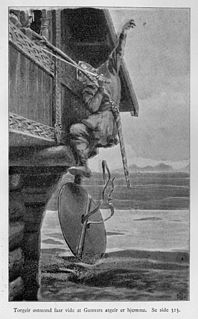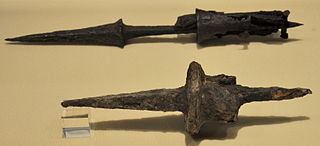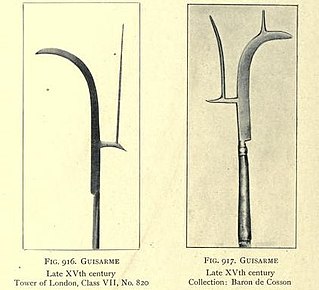 W
WA lance is a pole weapon designed to be used by a mounted warrior or cavalry soldier (lancer). During the periods of classical and medieval warfare, it evolved into being the leading weapon in cavalry charges, and was unsuited for throwing or for repeated thrusting, unlike similar weapons of the javelin/pike family typically used by infantry. Lances were often equipped with a vamplate – a small circular plate to prevent the hand sliding up the shaft upon impact. Though best known as a military and sporting weapon carried by European knights, the use of lances was widespread throughout Asia, the Middle East, and North Africa wherever suitable mounts were available. As a secondary weapon, lancers of the medieval period also bore swords, axes, hammers, or maces for hand-to-hand combat, since the lance was often a one-use-per-engagement weapon; assuming the lance survived the initial impact intact, it was usually too long, heavy, and slow to be effective against opponents in a melee.
 W
WAn atgeir, sometimes called a "mail-piercer" or "hewing-spear", was a type of polearm in use in Viking Age Scandinavia and Norse colonies in the British Isles and Iceland. It is usually translated in English as "halberd", but most likely closer resembled a bill or glaive during the Viking age. Another view is that the term had no association with a specific weapon until it is used as an anachronism in saga literature to lend weight to accounts of special weapons. Later the word was used for typical European halberds, and even later multipurpose staves with spearheads were called atgeirsstafir.
 W
WThe bill is a polearm weapon used by infantry in medieval Europe. The bill is similar in size, function and appearance to the halberd, differing mainly in the hooked blade form. Other terms for the bill include English bill, bill hook or bill-guisarme.
 W
WThe doloire or wagoner's axe was a tool and weapon used during the Middle Ages and Renaissance. The axe had a wooden shaft measuring approximately 1.5 metres (5 feet) in length and a head that was pointed at the top and rounded at the bottom, resembling either a teardrop or an isosceles triangle. The top of the shaft was fitted with a metal eye or socket that was welded to the head of the axe near the base of the blade. The upper part of the blade extended above the eye, while the opposite side of the socket featured a small blunt hammer head. The head of the axe itself measured approximately 44 cm. (17 inches) in length, was sharpened on the back and flattened bottom edges, and was uniformly decorated with punched and incised abstract floral patterns.
 W
WA fauchard is a type of polearm weapon which was used in medieval Europe from the 11th through the 17th centuries. In later use fauchards became ornamental and ceremonial, growing in size until some examples were almost too heavy to carry, let alone use. The design consisted of a curved blade atop a long pole, although in some portrayals, it is shown on a shorter pole. The blade bore a moderate to strong curve along its length. The cutting edge was only on the convex side of the blade, unlike the guisarme or bill. The fauchard was likely developed from the war scythe with the cutting edge turned opposite, convex instead of concave, so that the weapon was good for both thrusting and slashing attacks.
 W
WA glaive is a European polearm, consisting of blades on both the ends of a pole. It is similar to the Japanese naginata, the Chinese guandao and pudao, the Korean woldo, the Russian sovnya and the Siberian palma.
 W
WA goedendag was a weapon originally used by the militias of Medieval Flanders in the 14th century, notably during the Franco-Flemish War. The goedendag was essentially a combination of a club with a spear. Its body was a wooden staff roughly three to five feet long with a diameter of roughly two to four inches. It was wider at one end, and at this end a sharp metal spike was inserted by a tang.
 W
WA guisarme is a pole weapon used in Europe primarily between 1000 and 1400. Its origin is likely Germanic, from the Old High German getīsarn, literally "weeding iron". Like many medieval polearms, the exact early form of the weapon is hard to define from literary references, and the identification of surviving weapons can be speculative.
 W
WA halberd is a two-handed pole weapon that came to prominent use during the 14th, 15th, and 16th centuries. The word halberd is most likely equivalent to the German word Hellebarde, deriving from Middle High German halm (handle) and barte (battleaxe) joint to helmbarte. Troops that used the weapon are called halberdiers.
 W
WThe Lochaber axe is a type of halberd that was used almost exclusively in Scotland.
 W
WThe Lucerne hammer is a type of polearm which was popular in Swiss armies during the 15th to 17th centuries. It was a combination of the bec de corbin with the blunt war hammer.
 W
WA military fork is a pole weapon which was used in Europe between the 15th and 19th centuries. Like many polearms, the military fork traces its lineage to an agricultural tool, in this case the pitchfork. Unlike a trident used for fishing, the military fork was rarely barbed and normally consisted only of two tines (prongs) which were straight compared to the original pitchfork. The pair of tines usually ran parallel or slightly flared. This weapon was relatively easy to use compared to a sword, which could take years to learn how to wield effectively. It was usually used in absence of a spear. Like a spear, the Military Fork could be used in tight formations and was often made with various minor customizations to improve use; in the example of the image above, the fork has a hook parallel to the prongs intended to "catch" the blow of a weapon, as well as two "hooks" intended to dismount a knight from his horse.
 W
WA partisan is a type of polearm that was used in Europe in the 16th, 17th, and 18th century. It consisted of a spearhead mounted on a long shaft, usually wooden, with protrusions on the sides which aided in parrying sword thrusts. Like the halberd, it quickly became obsolete with the arrival of practical firearms, although it stayed in use for many years as a ceremonial weapon. In profile, the head of a partisan may look similar to that of a ranseur, spontoon, ox tongue, or spetum; however, unlike a ranseur, the lower parts of the head have a sharpened edge.
 W
WA pike is a pole weapon, a very long thrusting spear formerly used extensively by infantry. Pikes were used regularly in European warfare from the Late Middle Ages to the early 18th century, and were wielded by foot soldiers deployed in close quarters, until it was replaced by rifles, which had a longer range, and to which a bayonet could be attached. The pike found extensive use with Landsknecht armies and Swiss mercenaries, who employed it as their main weapon and used it in pike square formations. A similar weapon, the sarissa, was also used by Alexander the Great's Macedonian phalanx infantry to great effect. Generally, a spear becomes a pike when it is too long to be wielded with one hand in combat.
 W
WThe pollaxe is a European polearm that was widely used by medieval infantry.
 W
WA quarterstaff, also short staff or simply staff is a traditional European pole weapon, which was especially prominent in England during the Early Modern period.
 W
WA ranseur, also called roncone, was a pole weapon similar to the partisan used in Europe up to the 15th century. It was still seen in court as a ceremonial weapon through the 17th century.
 W
WA swordstaff is a Scandinavian polearm, used in the medieval ages. It is made by placing a blade at the end of a staff.
 W
WA lance is a pole weapon designed to be used by a mounted warrior or cavalry soldier (lancer). During the periods of classical and medieval warfare, it evolved into being the leading weapon in cavalry charges, and was unsuited for throwing or for repeated thrusting, unlike similar weapons of the javelin/pike family typically used by infantry. Lances were often equipped with a vamplate – a small circular plate to prevent the hand sliding up the shaft upon impact. Though best known as a military and sporting weapon carried by European knights, the use of lances was widespread throughout Asia, the Middle East, and North Africa wherever suitable mounts were available. As a secondary weapon, lancers of the medieval period also bore swords, axes, hammers, or maces for hand-to-hand combat, since the lance was often a one-use-per-engagement weapon; assuming the lance survived the initial impact intact, it was usually too long, heavy, and slow to be effective against opponents in a melee.
 W
WA voulge is a type of polearm which originated in medieval France. The weapon the term refers to is fraught with uncertainty as sources are unclear on the construction of this polearm. Therefore the weapon can only be known vaguely and must be guessed to with the circumstantial evidence at hand.